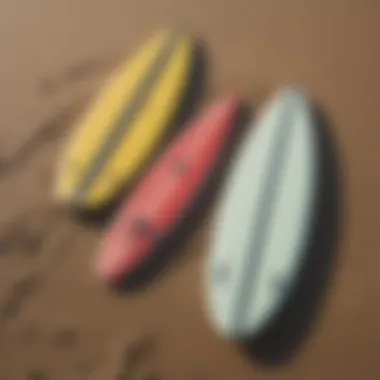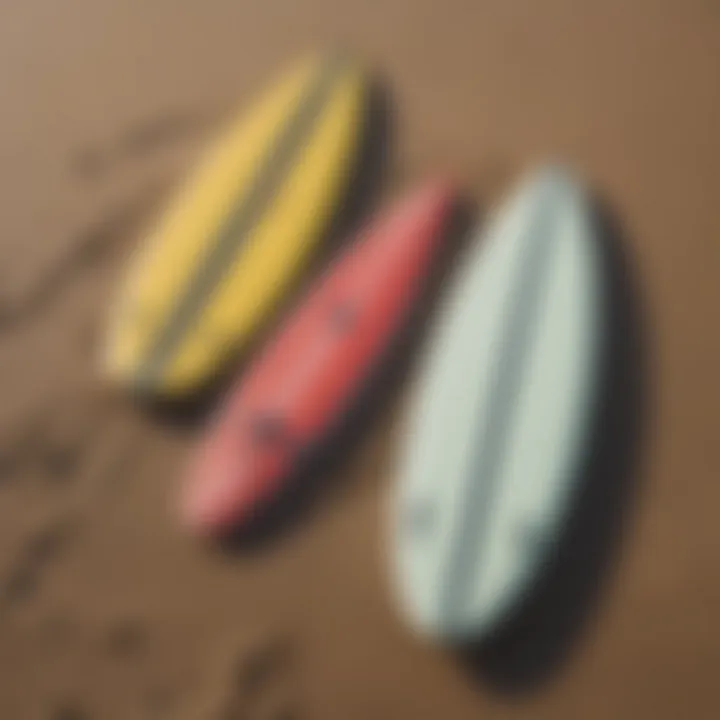Exploring Foldable Surfboards: The Future of Surfing Gear


Intro
Surfing is more than just a sport; it’s a way of life, a culture steeped in waves, sand, and the ocean’s allure. As surfers chase the perfect swell, the gear they ride has also evolved. One of the remarkable innovations emerging in recent years is the foldable surfboard. This new design concept doesn’t just bring convenience but also opens doors for creativity in the surf community.
Foldable surfboards promise ease of transport alongside enhanced capabilities on the water. For many, traditional surfboards can be cumbersome and less practical. The innovation of a surfboard that can fold might seem like a whim of the future, yet it holds practical benefits for the modern surfer. By delving into the intricacies of these boards, from their design to their material composition, we gain insights into their impact on the surfing landscape.
Many surfers, whether they've spent a lifetime mastering the waves, or are just catching their first rides, are drawn to the idea of equipment that adapts to their lifestyle. The structure of foldable surfboards not only reflects a shift towards user-friendly designs but also signals a push towards sustainability—a notion that resonates deeply within the surf community.
In this article, we will navigate the fascinating journey of foldable surfboards and evaluate their design, functionality, and user reception. We are eager to unpack various aspects such as historical context, material innovations, environmental considerations, and, importantly, the perspectives of those who ride these new boards.
As we go further into this topic, we will also touch upon comparative analyses against traditional surfboards. Through this comprehensive exploration, we aim to encapsulate not just the 'how' but the 'why' of the foldable phenomenon. The waves are calling—let's dive in!
Prelude to Foldable Surfboards
In recent years, foldable surfboards have made waves in the surfing world, marrying compactness with cutting-edge design to create gear that is as innovative as it is practical. As surfers seek ways to transport their boards without sacrificing performance, these foldable designs present a convenient solution that adapts to the modern surfer's lifestyle. With the growing trend of travel and adventure-seeking among surf enthusiasts, understanding foldable surfboards becomes crucial.
Defining Foldable Surfboards
Foldable surfboards aren't simply gimmicks; they are the result of years of engineering and design evolution. These boards typically feature a segmented construction that allows them to collapse into smaller forms for easy transport. Depending on the model, they may utilize a hinge or similar mechanism, making it not only possible for surfers to stow their gear with fewer hassles but also to navigate through crowded venues like airports and train stations with relative ease. For example, some boards can be folded into the size of a medium backpack, thus shaking off the extravagance usually associated with traditional surfboards.
"Foldable surfboards redefine the conventional surfing experience, enabling enthusiasts to explore remote beaches without the excess baggage that often accompanies standard surfboards."
Importance of Innovation in Surfboard Design
The surfing community has always valued innovation but now more than ever, it recognizes the necessity of adapting to a fast-paced, mobile lifestyle. The rise of foldable surfboards marks a pivotal moment in the industry, reflecting shifts in how surfers approach their sport. Innovation pushes the envelope: manufacturers are experimenting with new materials and sustainable practices, blending technology with traditional craftsmanship to offer a product that meets both performance and ecological needs.
Moreover, as environmental consciousness grows, the demand for more portable and efficient surfing gear becomes increasingly important. In this context, foldable surfboards play a critical role, not just in the enhancement of user experience, but also in fostering a culture of sustainability. The acknowledgment that surfboards must evolve to remain relevant in an age where convenience is key cannot be overstated.
In summary, the emergence of foldable surfboards introduces a sea change in surfing gear, appealing to a diverse range of users from casual beachgoers to avid adventurers. Through their innovative design and function, these boards redefine what it means to surf in a contemporary world.
Historical Context of Surfboard Evolution
Understanding the historical development of surfboards is crucial for comprehending the contemporary innovations, such as foldable designs. The evolution showcases not only shifts in materials and technology but also the changing experiences of surfers across decades. Recognizing the roots of surfboard design can illuminate the significance and practicality of foldable options, creating a solid bridge to understand their role in modern surfing.
Early Surfboard Designs
In the beginning, surfboards were crafted predominantly from solid wood. These cumbersome boards, often exceeding 10 feet in length, were a far cry from today’s sleek designs. Early Hawaiians, who are credited with surfing's inception, shaped these boards from local trees like koa and cedar. These materials were heavy, making the boards difficult to transport and maneuver in the water. The traditional surfboards usually weighed more than 100 pounds, posing a considerable challenge to surfers.
The craft of surfboard making was treated as an art form, with intricate patterns and symbols carved into the wood. However, the bulkiness of these boards limited the types of maneuvers and waves surfers could handle. This relatively rigid design set the stage for evolving styles and shapes as surfers began seeking lighter and more agile boards.
Shifts in Surfing Equipment Technology
The mid-20th century marked a significant turning point with the introduction of foam and fiberglass materials. What a difference a few innovations can make! The once-heavy wooden boards were replaced by these lighter alternatives, enhancing not only transportability but also performance. This shift made it possible for surfers to ride waves with greater speed and agility, ultimately transforming the sport.
Foam surfboards, emerging in the 1960s, were crafted from molded polystyrene and covered in fiberglass. This duality allowed for greater flexibility and a responsive ride, ushering in a new era of surfing. The shape and design became more experimental, leading to the shortboard revolution that would dominate the scene in the coming years.
The Rise of Portable Surfing Solutions
Fast forward to the 21st century, surf culture has seen a resurgence of interest in portability. With an increase in surfer mobility and the demand for travel-friendly products, manufacturers began focusing more on surfboard designs that could easily fit into car trunks and small apartments.
Foldable surfboards emerged as a viable solution. This innovation marries the historical need for adaptability with modern technological advances. Surfers can now enjoy the function of a traditional board without sacrificing the convenience of portability. This change is notably appealing for those living in urban environments or traveling frequently, as it addresses both performance and practicality.
In summary, the historical context of surfboard evolution sets the foundation for understanding the dynamics behind foldable surfboards. Recognizing how the introduction of new materials and designs has influenced performance and usability is essential for recognizing the importance of these modern innovations in the surfing community.
Mechanics of Foldable Surfboards
Understanding the mechanics of foldable surfboards is central to appreciating how these innovative designs enhance the surfing experience. A foldable surfboard is engineered for both convenience and performance, which is essential as the sport continues to evolve. As surfers look for ways to simplify transport and storage, the mechanics behind these boards come into play—addressing practical needs while maintaining functionality. This section discusses three key elements: the materials utilized, the construction techniques and design elements, and the unique functional features that these surfboards offer.
Materials Used in Foldable Designs
The choice of materials is crucial in the realm of foldable surfboards. Manufacturers are continuously experimenting, allowing for lightweight yet durable options that stand up to the wear and tear of the ocean.


Some commonly used materials include:
- Carbon Fiber: Known for its strength and light weight, it allows for agile handling while being pocket-friendly for transport.
- EVA Foam: This material provides excellent grip and cushioning. Its flexibility is vital in foldable designs, giving the board the ability to bend without breaking.
- Reinforced Polycarbonate Shells: Often used in conjunction, these materials offer enhanced durability. They ensure the board can withstand impacts without compromising its structure.
The combination of these materials not only adds to the performance but also aids in protecting the environment—many brands are looking at sustainable alternatives as a selling point in today’s eco-conscious market.
Construction Techniques and Design Elements
The construction of foldable surfboards is where innovation shines. Utilizing cutting-edge design techniques, manufacturers are able to merge functionality with performance.
Key techniques include:
- Modular Design: Many foldable boards utilize a modular approach, featuring sections that can easily connect and detach. This simplifies the foldability while maintaining a seamless feel when riding.
- Hinge Technology: Advanced hinge systems allow for smooth transitions between folded and unfolded states. Some companies are employing smart hinges that automatically lock into place during use.
- Layered Construction: Multiple layers can be added to enhance strength while minimizing weight. The layering technique allows for curves and contours that provide better hydrodynamic performance, making it essential for an enjoyable surfing experience.
These design elements not only focus on enhancing the user experience but also contribute to the overall aesthetic appeal of the surfboard.
Functional Features of Foldable Surfboards
The folding mechanism is just the tip of the iceberg when it comes to the functional features of these surfboards. The innovations present are tailored to meet the demands of contemporary surfers.
Some standout features include:
- Compact Portability: The primary benefit is the ease of transport. Surfers can fold their boards and store them in ordinary luggage or a small car trunk, making those spontaneous trips to the beach feasible without excessive gear.
- Versatile Adaptability: Many foldable surfboards are designed with adjustable fins, making them suitable for various surfing conditions. Surfers can easily change configurations based on the surf conditions, enhancing the overall experience.
- Enhanced Durability: Innovative designs tend to improve resilience against dents and scratches compared to traditional boards. This durability preserves the surfboard’s life, ensuring it's ready to hit the waves when desired.
"These boards are more than just a trend; they represent a shift in how we approach surfing gear—making it increasingly adaptable to modern lifestyles."
The merge of technology and utility in foldable surfboards reflects the forward-thinking nature of the surfing community. As we continue to explore this world, understanding the mechanics behind the construction and functionality of these boards becomes fundamental for anyone passionate about surfing.
Advantages of Foldable Surfboards
The concept of foldable surfboards has introduced a wave of opportunities for surfers at every stage of their journey. As enthusiasts of the ocean gear up for their next ride, the advantages these innovative boards bring are not just about convenience but also practicality, adaptability, and affordability. It’s a blend of creativity and functionality that reshapes the traditional dive into surfing.
Portability and Storage Solutions
One of the most striking features of foldable surfboards is their portability. Often weighing less than traditional surfboards, they can easily be tossed into the trunk of a car or strapped onto a bicycle rack. Imagine hopping on your bike with a surfboard coiled up tightly behind you, ready for a spontaneous trip to the beach.
When it comes to storage, these boards shine even brighter. Folks living in apartments or with limited garage space find foldable designs a true game-changer. Instead of cumbersome racks or finicky wall mounts, surfers can effortlessly slide their gear under the bed or tuck it into a snug corner of the living room. A foldable surfboard removes the clutter while providing a straightforward storage solution.
Adaptability for Different Surf Conditions
Another reason many surfers are seeking out foldable options lies in their adaptability. These boards can be tailored to various ocean conditions, allowing riders to switch it up as Mother Nature dictates. Whether you’re facing gentle waves or heavier surf, there’s a foldable design to match. Some inflatable models, such as those made by companies like ZONE, are specifically engineered for calmer waters, while others offer reinforced frames perfect for handling more aggressive swells. In short, a foldable surfboard can be a versatile partner in your surfing adventures, accommodating varying skill levels and environmental challenges.
Cost-Effectiveness in Modern Surfing
Modern surfing can be a wallet-draining hobby, but foldable surfboards offer a cost-effective alternative. They tend to be a fraction of the price of traditional boards due to reduced material needs and lighter manufacturing processes. This makes them accessible to newcomers who might be hesitant to drop significant cash on their first ride.
Moreover, these boards' sturdy construction often ensures lasting durability, meaning they can withstand the test of time without frequent replacements. For seasoned surfers looking to expand their collection without breaking the bank, incorporating a foldable surfboard into the mix can provide not only varied options but also an economical choice.
"Foldable surfboards are not just a passing trend; they answer real needs in the surfing community, blending practicality with performance."
Challenges and Limitations of Foldable Surfboards
The rise of foldable surfboards, with their innovative designs, brings about a wave of excitement in the surfing community. However, tackling the challenges and limitations of these evolving tools is essential for both enthusiasts and manufacturers alike. Understanding these hurdles helps surfers make informed decisions about incorporating foldable models into their gear collection. Certain concerns about durability, performance, and user adaptation can significantly impact the surfer's experience and for many reasons, these aspects warrant further discussion.
Durability Concerns in Design
Durability is a critical factor for any piece of sporting equipment, and surfboards are no exception. Foldable surfboards leverage lightweight materials and advanced engineering, which leads to questions around their longevity. Traditional surfboards are often made from solid foam or fiberglass, materials known for their resilience against waves and wear. In contrast, foldable boards may utilize composites and polymers that, while beneficial for portability, may not hold up as well in the rough and tumble of everyday surfing.
Surfers often express concern about the potential for wear and tear when utilizing these boards. Small punctures, hinge failures, or the possibility of delamination raises red flags for many. Moreover, frequent folding and unfolding can lead to stress fractures. Although manufacturers are working hard to enhance material strength and design, the realization that foldable surfboards might require more careful handling cannot be overlooked.
Performance Comparison with Traditional Boards


When discussing performance, one must consider how foldable surfboards measure up against their traditional counterparts. While many new surfers are excited by the idea of lightweight and compact boards, the performance aspects often leave something to be desired.
- Stability: Traditional boards often provide greater stability on the waves due to their solid structure. Foldable surfboards, due to their design, might compromise this stability, which can lead to a less enjoyable ride, especially for less experienced surfers.
- Speed and Maneuverability: Speed is crucial in surfing. Many foldable options might not glide through the water as quickly as standard boards. Some users note that, in challenging surf conditions, a foldable board requires greater effort to achieve desired maneuvers.
- Paddle Efficiency: Effective paddling is essential for catching waves. Foldable surfboards may differ in their paddle efficiency due to varying shapes and weight distributions. Users might find that adjusting to a foldable board can alter the rhythm they’ve established with traditional boards.
User Adaptation and Learning Curve
Adapting to a new style of board often involves a learning curve that can be a double-edged sword for surfers transitioning to foldable designs. While they are marketed as user-friendly and accessible, the reality of familiarizing oneself with a new setup can become daunting.
For beginner surfers, using a foldable surfboard may exacerbate the initial challenges they face. Many beginners may struggle with balancing the unique characteristics of the board while trying to learn fundamental techniques. This adaptation phase can lead to frustration and a decrease in motivation.
Conversely, experienced surfers attempting to switch to a foldable model may find themselves grappling with altered feel and performance. Practicing maneuvers that come naturally on their tried-and-true boards might take extra time and effort on foldable designs.
"Transitioning to a foldable surfboard is like learning to ride a bike with training wheels – what seems simpler at first can feel more complicated as you hit the surf."
The gap between expectation and reality in the surfing experience with foldable surfboards is significant. Understanding and acknowledging these challenges ensures that surfers can better prepare for the shift, making the transition smoother and more enjoyable. It’s essential to weigh the benefits of portability against these limitations before diving into what may feel like uncharted waters.
User Experiences and Perspectives
When it comes to foldable surfboards, firsthand accounts from users play a crucial role in understanding their practicality and limitations. How a piece of equipment performs in real-world conditions can reveal insights that technical specifications alone might miss. User experiences not only illuminate the advantages but also highlight some of the pitfalls that might not be immediately apparent. For surfers, whether seasoned professionals or newcomers, their interactions with this innovative gear can shape opinions and influence future designs.
Feedback from Beginner Surfers
For beginners, the appeal of foldable surfboards is often rooted in their promise of convenience.
- Portability: Many new surfers appreciate the ability to pack their boards easily into a compact size, avoiding the daunting transportation issues that traditional boards can present.
- Learning Curve: Beginners might find the softer edges and flexible designs of some foldable surfboards more forgiving when they fall or wipe out, as the boards tend to absorb some shocks that might otherwise be painful. However, it is not all smooth sailing. Some newcomers express concerns around stability.
A common sentiment among amateur surfers is, "I wasn't sure if I'd feel wobbly on it, like a mix between a board and a noodle." This highlights a valid concern — the stability can vary greatly depending on the brand and specific model.
Insights from Professional Surfers
Professional surfers approach foldable boards with a more discerning eye. While the idea of a portable surfboard is an attractive concept, it must also meet the extreme demands of competition.
- Performance: Surfing world remains skeptical at times, some have voiced ambivalence. Their feedback reflects their high expectations. Pros often note that not all foldable boards can withstand heavy waves without compromising performance.
Many insist that these boards tend to lack the drive and momentum found in traditional designs. They articulate their experiences, stating, "Flexibility can be fun, but when I want to catch that wave, I need a board that’s going to respond instantly."
Yet, a few advanced users find value in hybrid setups, using foldable surfboards for specific contexts such as travel or practice in less challenging conditions.
Community Reception and Trends
In the wider surfing community, the reception of foldable surfboards is a mixed bag. Social media forums and platforms like Reddit have seen enthusiastic discussions around them. Feedback varies widely, but some trends have emerged:
- Eco-conscious Consumers: More surfers are showing interest in sustainable options. Foldable boards made from environmentally friendly materials often gain a following, as they resonate with the community’s increasing focus on sustainability.
- Innovations in Shape: As newer models hit the market, surfers share their impressions on designs. Some say certain models feel like a "breath of fresh air" in how they handle waves compared to older foldables.
"Surfing is as much about the experience as it is about the gear. If foldable boards can enhance that experience while being eco-friendly, they're worth a shot."
This insight reflects a broader acceptance of innovation, suggesting an increasing willingness to adapt to new technologies when they offer proven benefits.
As the community continues to engage with these products, both the challenges and benefits encountered by users will essentially dictate the future trajectory of foldable surfboards in surfing culture.
Environmental Implications of Foldable Surfboards
The rise of foldable surfboards is not only a testament to innovation in design but also a crucial factor in addressing environmental challenges within the surfing community. As surfers are increasingly becoming aware of their ecological footprint, the demand for gear that promotes sustainability is more pertinent than ever. Foldable surfboards offer not just a space-saving solution, but they also present unique advantages in terms of material usage, manufacturing processes, and their overall impact on marine environments.
Sustainable Materials in Surfboard Construction
When we dive into the topic of sustainable surfboards, it’s essential to look at what materials are now being used in their construction. Unlike traditional boards, which often rely on polyurethane foams and fiberglass, many foldable surfboards are made from eco-friendly components.
These include:
- EPS (Expanded Polystyrene): A lightweight foam favored for its recyclability and lesser environmental impact.
- Biodegradable Resins: Unlike conventional polyester resins, these blend naturally with the environment.
- Bamboo and Cork: Both are renewable resources that lend flexibility and strength, while also being more sustainable compared to their synthetic counterparts.
By selecting materials that are gentler on the earth, manufacturers are adopting practices that align better with the values of eco-conscious surfers, ensuring they ride waves without leaving a heavy footprint behind.


Reducing Carbon Footprint for Surfers
The issue of pollution and climate change looms large, even in the bustling world of surfing. Foldable surfboards can significantly reduce carbon footprints through several means. Firstly, their transportability often means that surfers can consolidate their gear, decreasing the need for multiple boards which would otherwise consume energy in production and transportation.
Additionally, the manufacturing processes for these boards are evolving:
- Local Production: Many companies are embracing localized manufacturing to minimize transportation emissions.
- Streamlined Designs: Foldable boards typically require fewer materials thanks to their construction techniques, which leads to less waste during production.
By adopting foldable surfboards, surfers can proudly contribute to a smaller environmental impact, making choices that resonate with the ethos of conservation.
Promoting Ocean Conservation Awareness
As surfers, we naturally develop a bond with the ocean, a relationship that comes laden with responsibilities. Foldable surfboards encompass more than just a new gear option; they promote a broader awareness of ocean conservation.
Through marketing and education, brands often highlight their commitment to sustainable surfing practices. This includes:
- Educational Campaigns: Many surfboard manufacturers share insights on marine life, pollution, and sustainable surfing practices, fostering a culture of responsibility.
- Collaborations with Conservation Groups: Brands partner with organizations dedicated to ocean cleanup projects, beach preservation, and wildlife protection.
"The ocean gives us so much, yet it is in peril. It’s our duty to ensure that our passion does not contribute to its decline."
By choosing eco-friendly products, surfers can embody the spirit of stewardship for ocean health, encouraging others in the community to follow suit. Through this collective consciousness, foldable surfboards can serve as a rallying point for environmental activism within the surf community.
Future Trends in Surfboard Technology
The landscape of surfing equipment is evolving constantly, with foldable surfboards leading the charge in innovation. This section sheds light on future trends in surfboard technology, emphasizing what surfers and manufacturers should keep an eye on.
Innovative Materials and Designs
The search for more efficient materials is crucial in enhancing surfboard functionality. Manufacturers are diving deep into alternatives to traditional polyurethane foam. For example, biodegradable resins are becoming a hot topic. These materials not only reduce environmental impact but also maintain performance characteristics. Imagine a surfboard that decomposes instead of polluting the ocean!
Some designers are exploring carbon fiber and aramid fiber, which are lightweight yet exceptionally strong. They allow for radical new board shapes and folding mechanisms, creating options for riders that seem almost futuristic.
Moreover, modular designs—where components can be swapped for different conditions—are gaining traction. This adaptability caters to the varied surfing styles and skill levels present in the surfing community.
The Role of Technology in Surfboard Development
Technological advancements don’t just stop at materials; they extend into how boards are crafted. The rise of 3D printing is notably reshaping production methods. A surfer could potentially design their own board, tweaking each detail to their preference and having it printed to order. This process not only streamlines production but reduces waste significantly.
Advanced computer simulations are enabling designers to predict how boards will perform under various conditions before they even hit the water. This kind of simulation equips surfers with the knowledge to tailor their equipment for specific surfing scenarios, ushering in a new level of personalization in surfing gear.
Predictions for the Next Generation of Surfboards
Looking ahead, it’s clear that the next generation of surfboards will blend culture, technology, and environmental consciousness. Here are some predictions:
- Smart Surfboards: Future boards may incorporate sensors to track performance metrics like speed and wave height. Surf apps could connect with these boards for personalized coaching.
- Eco-focused: Expect more surfboards made from recycled materials. Companies may create an entire line of environmentally friendly products, resonating with today's eco-conscious surfers.
- Enhanced Portability: As more surfers travel, foldable or modular boards will gain popularity, facilitating ease in transportation without sacrificing performance.
By analyzing these prospective changes, it is apparent that technological integration into surfboard design will greatly impact surfing in the years to come.
"With advancements in surfboard tech, we aren't just riding waves; we’re pioneering an era of conscious surfing."
The intersection of innovation and the timeless passion for surfing is a thrilling realm to watch as it evolves.
Epilogue
As we draw the curtains on our exploration of foldable surfboards, it’s essential to reflect on their significant impact on the surfing world. The topic of foldable surfboards not only exemplifies technological advancement but also highlights how innovation can redefine norms in any sport.
Summarizing the Evolution of Foldable Surfboards
The journey of foldable surfboards traces back to the confluence of necessity and imagination. The early surfboards were bulky and cumbersome, challenging for even the most seasoned surfers to transport or store. With time, as surf culture burgeoned, so too did the need for designs that adapt to the fast-paced lifestyle of surfers. The introduction of portable and foldable models allowed for greater accessibility, enabling surfers to hit the waves without the hassle of traditional gear.
The evolution has seen materials like fiberglass and foam morph into resilient, sustainable options that maintain performance while promoting eco-friendliness. Additionally, the integration of advanced engineering in design has lead to boards that not only fold but preserve the integrity required for high-performance surfing. Users have reported improvements in convenience and adaptability, making foldable surfboards a practical choice at a surf spot or while traveling.
Final Thoughts on Future Innovations
Looking into the near future, one can hardly overlook the promise that lies with foldable surfboards. As technology continues to weave itself into fabric of sports gear, we can expect to see further advancements that enhance performance.
Innovations may focus on ultra-lightweight materials that still deliver strength, enhancing the user experience. Expect to see boards that fold even more compactly, providing greater ease in transport. Additionally, smart technology integration could offer real-time feedback on surfing conditions, thus elevating the surfing experience. The community is leaning into this wave, suggesting that our expectations around surfboard design will evolve dramatically over the coming years.
In summary, as we're navigating this fascinating intersection of technology and surfing culture, foldable surfboards carve a unique niche—one that exemplifies efficiency without sacrificing thrill. As surfers, enthusiasts, or simply people who appreciate innovation, there's much to look forward to as we ride this evolving wave.















